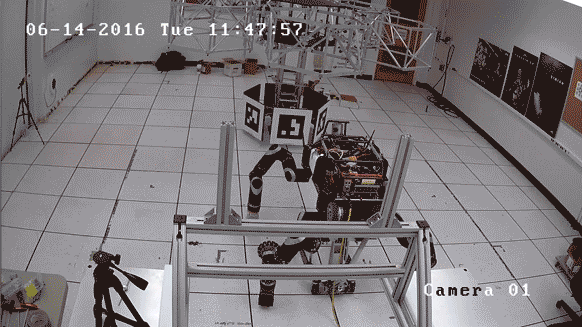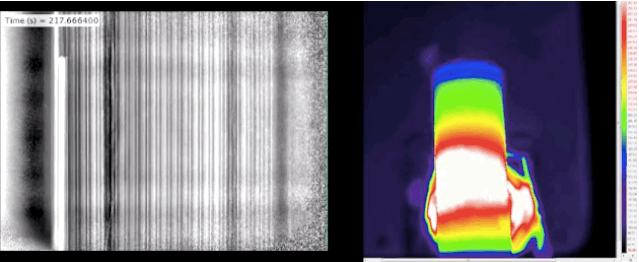What caused the Nashville explosion?
1. Gas
2. Lithium-ion batteries - Battery Room Explosion
A lithium-ion battery or Li-ion battery is a type of rechargeable battery. Lithium-ion batteries are commonly used for portable electronics and electric vehicles and are growing in popularity for military and aerospace applications. Source
Here's what happens when Lithium-ion battery over heats....
Lithium ion batteries are practically ubiquitous; they power everything from laptops and cell phones to cameras and tablets. But before they can start providing the juice for bigger and more demanding applications, research about their failure needs to happen. That's where the fine folks at University College London come in -- they've used 3D-and-thermal imaging to track exactly what happens when the power cells overheat, inside and out. As you can see in the GIF above, the results aren't pretty. After cranking the heat on a pair of the batteries to 250+ degrees Celsius (482 degrees Fahrenheit) and keeping an eye on them with the aforementioned techniques, researchers witnessed one of the batteries blow its top. Prior to that happening, during what's known as "thermal runaway," the core collapsed.
What's that mean?
Well, according to the paper published in Nature, the change in temperature that lead to a destabilizing further change in temperature elevates the risk for internal short circuiting and damaging any nearby components. That only happened in a battery without internal support, though. The cell that wasn't lacking such a feature was a bit different. After hitting about 1,000 degrees Celsius (1,832 degrees Fahrenheit) the copper internals melted, the heat spread outward and caused thermal runaway. It sounds quite a bit less violent, actually.
This isn't the sort of thing that would happen under normal operating conditions at all, and UCL's Dr. Paul Shearing readily admits that. However! He says that this sort of testing provides invaluable knowledge regarding how the lithium-ion cells fail and will hopefully help how safety aspects are designed and considered in the future. I'd imagine that Boeing is paying pretty close attention to these experiments. Call it a hunch. Source
ATT Building On Right
Battery Room Explosion:
A hydrogen explosion occurred in an Uninterruptible Power Source (UPS) battery room. The explosion blew a 400 ft2 hole in the roof, collapsed numerous walls and ceilings throughout the building, and significantly damaged a large portion of the 50,000 ft2 building. Fortunately, the computer/data center was vacant at the time and there were no injuries.
The facility was formerly a large computer/data center with a battery room and emergency generators. The company vacated the building and moved out the computer equipment; however the battery back-up system was left behind. The ventilation for the battery room appeared to be tied into a hydrogen monitoring system. The hydrogen sensor was in alarm upon emergency responders arriving at the scene (post-explosion). 911 callers reporting the explosion also reported hearing an alarm for 3 days prior to the explosion. This appears to have been a local alarm, as it was not relayed at any time to the local fire department. Given how slowly batteries generate H2 (1.3x10-7m/s per amp-cell), it appears as though batteries were charging for a long period of time with no ventilation. Apparently the detector was alarming, and hydrogen continued to build up until it found an ignition source. Due to the damage and actions of emergency responders shutting off all circuit breakers, etc., it could not be verified whether the ventilation system failed, or was previously turned off when the building was vacated. Onsite personnel assumed that the ignition occurred at or near a grounding strap on the battery racks, but in a room full of batteries and electrical equipment, ignition sources are plentiful.
Lessons Learned
Lessons Learned
The lesson to pass on is that ventilation is critical in UPS battery rooms. Great care should be taken to ensure that the ventilation system is operational and brings in enough outdoor air to properly ventilate the enclosure. Electrical safety interlocks should also be considered, which would isolate the batteries from their power supply, not allowing the batteries to charge if the ventilation system isn't working properly. It is imperative that the battery room designers pay close attention to the design of ventilation systems and electrical safety interlocks. There are lots of good (and bad) ways to design and install battery rooms and critical ventilation systems. If designers do not have experience designing UPS battery rooms, experienced consultants should be contacted to ensure a safe and effective design. In addition, internal management procedures need to be developed which analyze operation of such systems. As in this case, the entire data center was removed and the UPS system was no longer needed. The UPS system should have been decommissioned when the data center was removed. A good management-of-change procedure would have uncovered this problem before it became an incident. More information on management of change can be found in the Lessons Learned Corner and also in the Hydrogen Safety Best Practices Manual.
Source
Footage after Nashville explosion pic.twitter.com/sm68yaOeTZ
— 🇺🇸🦅M💥A💥G💥A🦅🇺🇲 (@BlessUSA45) December 27, 2020




No comments:
Post a Comment